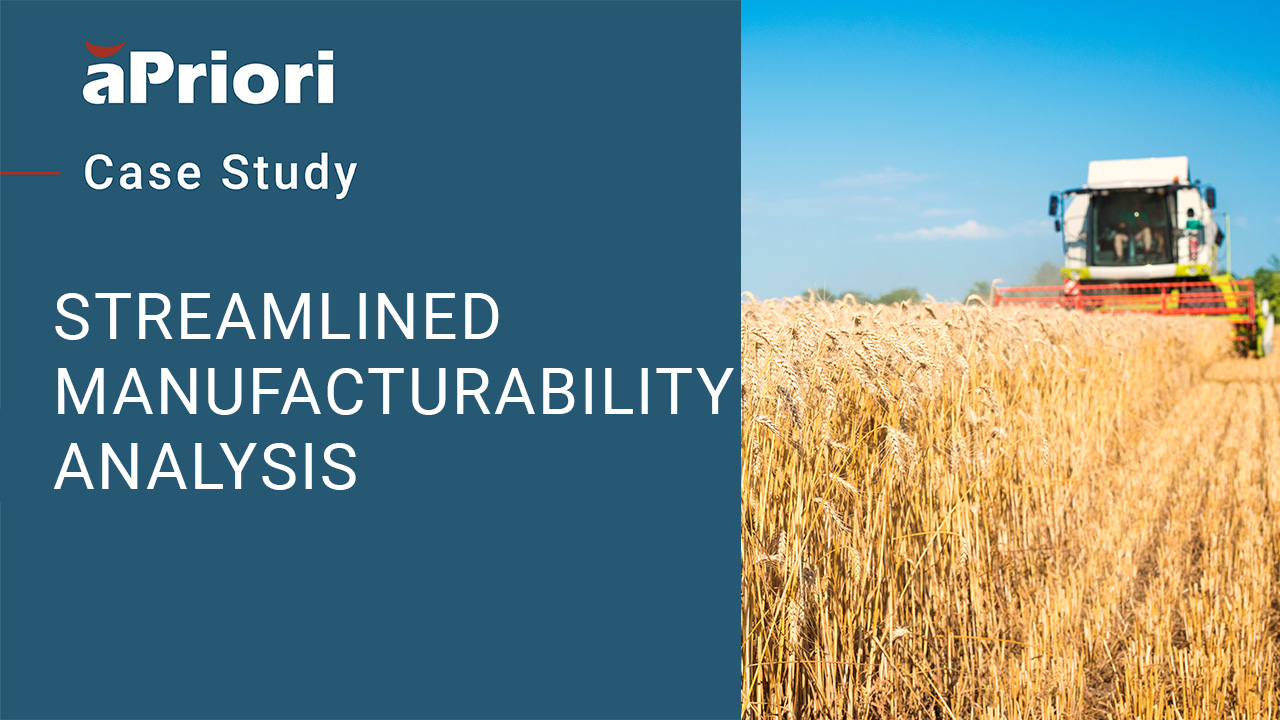How Sustainability Creates Opportunities in Agricultural Manufacturing
Key Takeaways:
- Digital manufacturing enables cross-team collaboration and insights to boost speed and profits
- AGCO identifies up to $30 million in potential cost savings with aPriori
The Full Article:
Today’s agricultural manufacturing companies are integrating sustainability into their products to tap into eco-conscious market segments, satisfy sustainability regulations, and reduce negative climate impacts.
AGCO Corporation, a leading agricultural equipment manufacturer (AEM), is taking a leadership position in decarbonizing its value chain (Scope 3) and developing sustainable products. According to AGCO’s 2022 Sustainability Report, the company achieved its decarbonization targets three years ahead of schedule by “reducing the emissions intensity of manufacturing operations by 31%.”
The manufacturer’s commitment to sustainability extends to the agricultural products it provides consumers. AGCO’s new Power CORE™ engines with renewable diesel enable farmers to reduce their machinery greenhouse gas emissions (GHGs) by 90%. AGCO also develops and specializes in low-carbon tractors, combine harvesters, seeding and tillage equipment, smart farming solutions, and more.
Challenges in the Agricultural Sector
Sam Freesmeyer, former VP of Engineering for AGCO, is a pioneer in harnessing digital technologies to improve product development efficiency. Freesmeyer discussed the common, shared challenges that manufacturers across industries face at aPriori’s Manufacturing Insights Conference. An overview of these industry challenges follows.
Disconnected Product Teams and Siloed Technologies
According to Freesmeyer, siloed technologies and ineffective collaboration across internal product teams pose significant challenges in agricultural manufacturing. “I’m learning that there are some problems common to every company,” said Freesmeyer. “One of those problems is the ability to develop new products and maintain current innovations across functional lines.”
It is challenging to bring stakeholders from across the product development ecosystem together due to each function’s unique roles, responsibilities, and key performance indicators (KPIs). And departments may use different technologies to complete their specialized tasks, which creates another barrier to effective cross-functional collaboration. Disconnected product teams and siloed manufacturing data can cause the following:
- Significant delays in new product introduction (NPI) processes
- Late-stage engineering change orders (ECOs) leading to expensive product redesigns
- Poor decision-making based on questionable, outdated information across isolated systems
- Several sources of truth that create data inconsistencies and hinder effective collaboration
- Duplication of efforts which results in wasted time, resources, and increased costs
Labor Shortages in the Agricultural Industry
According to Freesmeyer, the agricultural industry faces critical skill and labor shortages, resulting in a declining on-field, next-generation workforce.
“We’re seeing many baby boomers coming into retirement and leaving the workforce. And the replacement value of future generations is smaller,” said Freesmeyer. “Farming is a great case study for that. If you look at on-farm labor 70 years ago, three-fourths of our population was involved in farming. Now it’s less than two percent.”
Manufacturers are addressing the labor shortage by providing larger agricultural equipment to make the remaining farm workforce as efficient as possible. However, Freesmeyer believes the labor shortage may present an opportunity for sustainable manufacturing innovation to reduce the industry’s environmental impacts.
“There’s a huge paradigm shift coming in agricultural technologies as we finally make the shift to full autonomy and robotics in the field,” said Freesmeyer. “I think we’ll see smaller machines do sustainable farming. There’s a significant change coming, and it’s driven by new technology. But we must also consider and address the costs of these new sustainable innovations.”
Balancing Product Cost, Sustainability, and Manufacturability
Agricultural manufacturing companies may lack real-time visibility into the impact of design and production decisions on product cost, sustainability, and manufacturability. Companies focusing solely on product sustainability often disregard manufacturing expenses, resulting in strained profitability and limited market competitiveness.
Freesmeyer believes digital solutions with highly visible manufacturing insights can help companies balance cost and carbon while maintaining product quality. “As we gain better visibility into the parts that make up our complex products, we can start to project how it will affect our cost and profitability,” said Freesmeyer. “There are two pieces here to manufacturing sustainability. One, we must have the tool, and two, the willingness to put it into our companies.”
Digital Manufacturing Software Improves Collaboration and Decision-Making
Leading organizations are leveraging digital manufacturing software, such as aPriori, to identify and eliminate cost, carbon, and manufacturability issues early in design. aPriori automatically extracts geometric data from 3D CAD models checked into their product lifecycle management (PLM) systems to deliver precise, real-world manufacturing insights. aPriori’s powerful features and capabilities include the following:
- End-to-End Digital Twins. aPriori’s automation-driven platform leverages the digital thread to connect three digital twins—product, process, and factory—to unlock actionable, real-time insights. aPriori digital factories are configurable and can simulate production based on product design (geometry), energy consumption, machine availability, manufacturing processes, overhead rates, and more. The aPriori solution provides these insights utilizing real-world manufacturing process models and economic conditions for 87 regions across the globe.
- Centralized Manufacturing Data and Automated Alerts. With aPriori, cross-functional teams only use one source of truth to access product, material, and manufacturing process insights. Project stakeholders can collaborate to make informed, data-driven decisions to design innovative products faster. Further, aPriori sends automatic notifications with guidance to help teams identify and eliminate early design-stage product cost, carbon, and manufacturability problems. This enables companies to accelerate product development, improve time to market (TTM), maximize competitiveness, and maintain profit margins.
- Gain Additional CO2e Insights. Teams can complement their life cycle assessment (LCA) tools and build on their “cradle-to-grave” product environmental impact reports with aPriori. aPriori’s latest solution for sustainability provides product teams with rapid “cradle-to-gate” carbon calculations during the early and critical design stage. aPriori calculates carbon dioxide equivalent (CO2e) emissions based on the rough mass, cycle time, and energy consumption used to make parts or assemblies.
AGCO Identifies Up to $30 Million in Potential Cost Savings With aPriori
As a current customer, AGCO employs aPriori’s automated digital factories to standardize manufacturing cycle time and cost modeling analyses. At our most recent conference, Freesmeyer spoke about the benefits of using aPriori, “Digital solutions like aPriori can help cross-functional teams control the uncontrollable. There are many opportunities in the agricultural space to reduce environmental impacts, but it requires better control of cost and the supply chain. And those are some of the things that aPriori is addressing.”
According to Freesmeyer, the aPriori Manufacturing Insights Platform helped AGCO’s product cost optimization team identify up to $30 million in potential savings. He anticipates that aPriori’s new coworking and sustainability solutions will help AGCO achieve even better collaboration efficiency to hit environmental and profitability targets simultaneously.
Grow Innovation and Achieve Profitability With Digital Manufacturing Insights
Digital solutions like aPriori are critical in breaking down organizational silos, increasing cross-functional team collaboration, and improving decision-making processes. With the insights and capabilities that aPriori provides, agricultural manufacturing companies can innovate to achieve sustainability and bottom-line targets quickly and effectively.
How AGCO Streamlines Manufacturability Analysis With aPriori
Discover how AGCO leverages aPriori’s digital factories to standardize manufacturability analysis.








